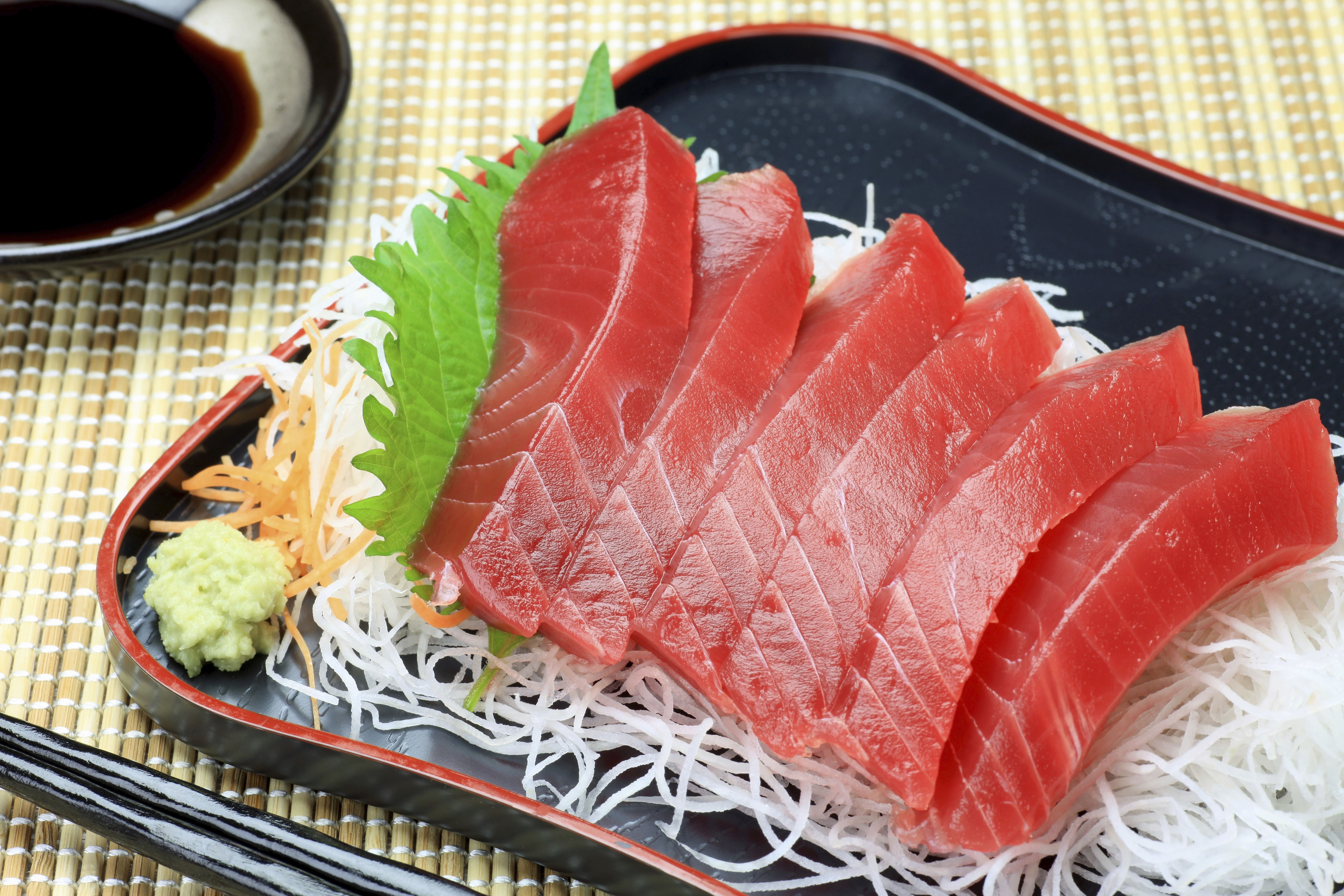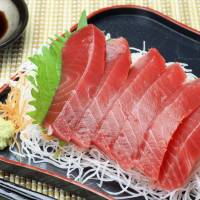Dear Alice,
I have been wondering about something for a long time: Why is sashimi always served on those piles of stringy daikon radish? Has this always been the case? Does the daikon serve any purpose, or is it just there for decoration? Also, what the heck are you supposed to do with it? Eat it or leave it on the plate?
James S., Tokyo
Dear James,
The finely sliced daikon that comes under or around slices of raw fish is called "tsuma." That's actually a generic term that can be applied to any of the many edible garnishes used to embellish presentations of sashimi. Common examples are artfully carved carrot strips, tiny whole chrysanthemum flowers, red and green seaweeds, and finely sliced myoga, the flower buds of the ginger plant. Yet the piles of white radish are so ubiquitous that, for most people, "tsuma" is pretty much synonymous with daikon.
And speaking of synonyms, you probably know that "tsuma" also means "wife," and are wondering whether there's a connection. One theory as to why sashimi garnishes are called what they are goes like this: A plate of raw fish is like a happy household, in which the sashimi (the "husband") exists in harmony with the supportive yet subordinate garnishes (the "wife"). Perhaps, but there are telling differences in how the two words are written.
The kanji for tsuma-meaning-garnishes includes the character for tsuma-meaning-wife, but with the addition of the "koromo hen" radical for clothing. Written this way, the character also refers to the lower front panel of a kimono, which is read — you guessed it — "tsuma"! So a second theory, which I find more plausible, is that "tsuma," written with the clothing radical, was applied to garnishes because it means something at the side or edge.
Turning now to history, I put in a call to Ayao Okumura, a chef, food consultant and cookbook author with a special interest in how Japanese cooking developed. He explained that the custom of eating raw fish was actually introduced to Japan from China, and perhaps as early as during the Kamakura Period (1185-1333). At that time, the Chinese ate raw fish, including carp and sea bass, chopped into pieces and tossed with strongly flavored vegetables such as scallions and garlic. This was the way the Japanese initially consumed raw fish, too. The practice of eating raw fish died out in China, but only grew in popularity in Japan, although it remained a luxury only enjoyed by aristocrats.
One of the oldest known cookbooks in Japan is the "Shijoryu Hochogaki." It was written in 1489, in the middle of the Muromachi Period (1392-1573), and includes instructions on preparing raw fish for consumption. The fish should be very carefully sliced, then mixed with vinegar flavored with any number of possible variants. Examples given include salt, wasabi, ginger and a peppery leaf called date, which is a flowering plant in the buckwheat family.
Those ingredients originally served important functions, according to Okumura. "Remember that this was in the days before refrigeration," he said. "Highly flavored and aromatic ingredients were added to mask fishy tastes and smells. But they also slowed the rate of spoilage because, as we now know, many of these foods, and especially wasabi, contain natural anti-bacterial compounds."
The way we enjoy sashimi today — a presentation of plain slices of fish or shellfish that can be dipped in soy sauce to taste — was a much later development. "That style of eating raw fish didn't come about until late in the Edo Period (1603-1868)," Okumura said. Instead of mixing the sauces and vegetables into the fish, sauces were offered in separate dishes on the side, and the vegetables and other edibles were placed under or around the fish.
"As transportation and storage of fish improved, there was less need to mask odors and off tastes, so the original function of tsuma was lost," Okumura said. "These days, tsuma are used only to make the presentation more attractive. The colors of the vegetables and seaweeds make the fish look more appetizing, and you can add a sense of the season by including seasonal flowers and plants."
There is, however, a new trend to use fewer tsuma, moving away from big, busy presentations. "The current thinking toward tsuma is that less is more," Okumura commented. "We're seeing less daikon, and a more measured use of other garnishes, too."
This reminds me of a colloquialism that seems to illustrate just how far tsuma have fallen since the glory days: The phrase "sashimi no tsuma" ("the garnish for sashimi") can be used to mean someone or something is of little consequence. You can say, "Kono ken ni tsuite, kare wa sashimi no tsuma no yōna mono da." ("On this matter, he's like the garnish for sashimi.") This means the person's input and opinion are unimportant, and there's no reason to take them into account.
But let's get back to your final question: do you, or do you not, eat the daikon? Earlier this year, there was an online survey in which more 12,000 men and women offered their views. While some maintained it is a bad manners to down the decorations, and others said they won't touch the daikon because it's contaminated by blood from the fish, fully 76 percent of respondents said they do eat the tsuma. I thought it best to let Okumura have the final word.
"It's fine to eat the tsuma," he assured me. "You might get a little extra nutrition, and you can certainly enjoy the different flavors and textures."
He did, however, add one caveat: "Just don't eat the whole chrysanthemum flowers. The petals are fine, and are often used in fall dishes, but they really should be lightly boiled first."
Notice
Sadly, this is the final installment of this column, which has run since 2005.

















With your current subscription plan you can comment on stories. However, before writing your first comment, please create a display name in the Profile section of your subscriber account page.